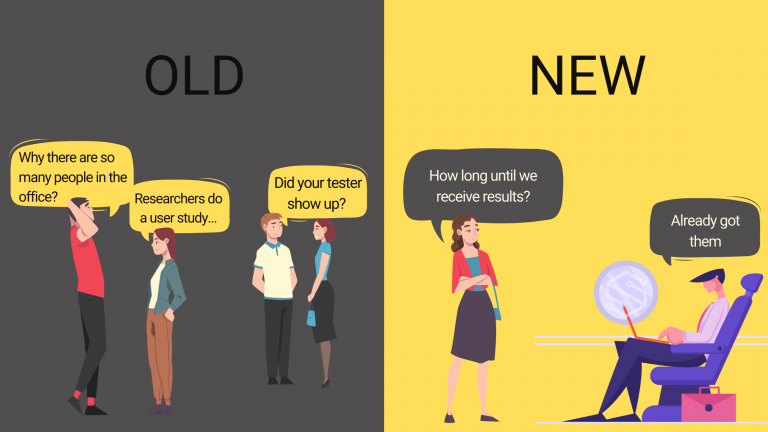Why and when should I run a UX/ UI user test study?

We see a lot of articles about the importance of UX (user experience) and UI (user interface) and more and more companies are looking for employees with this expertise. UX and UI professionals are in high demand today. But what are UX and UI really? Why is it suddenly so popular and important? And why should you run a user test study?
First, we need to understand what is and what is the difference between UI and UX

UI = User Interface
UI stands for elements that the user has to interact with. This includes screens, a keyboard, sounds, lights, and placed elements.
The user interface (UI) of each website and product should be tailored to the customer’s wishes, and it should be clear and very simple in order to create a good user experience (UX).
Comparison: You have a store in the mall, but no one comes in. Why? Maybe there is no door handle? Maybe the signboard is too small? Or is the lighting too quiet and it seems closed? Maybe people are coming in but not buying anything because of a lack of a fitting booth?
UX = User Experience
This is the result of the user interface (UI). It is the experience that results from the customer interacting with all the elements. It can be positive, neutral, or negative.
Comparison: You have a store in the mall, but people leave immediately after they enter. Maybe the shop smells bad? Or the seller gives such a furious look that it inadvertently frightens all customers? Maybe customers can’t see what they’re looking for right away because the most requested items are hidden in the back?
UX/UI design
UI and UX are most commonly used together when it comes to design and designers. UX / UI design is based on the customers and their path to the website. Everything is tailored to help achieve the purpose of the website (such as a purchase). The designer creates the website so that the user does not leave the page in the first seconds and wants to stay longer. To achieve this, you need to create visually pleasing, structured, and well-designed content that includes appropriate CTA (click-to-action) buttons. Every detail of a website needs to be customer-centric, and UI / UX designers are working to achieve that.
So the UI is the user’s interface with your product and it’s important to customize the elements to create a good UX experience or the way to use the product. UI / UX designers are fairies who do it with a magic wand (including user tests).
Why is UX & UI suddenly important?
With the onset of the global Covid-19 crisis, users have become more impatient and demanding. People began to use virtual products and tools and the importance of UI / UX grew. As soon as the user/customer has a negative experience (the page loads too long, too many moving ads, the desired product cannot be found quickly, the purchase process takes a long time, etc.) they leave the page and go to a competitor. Sure, you can say – “I don’t care, they can buy from others!” However, research shows that in case of a bad experience, the user shares this experience with up to 16 friends! This means that you are more likely to lose 16 potential customers as a result of a bad experience.
The best way to understand what works and what doesn’t is to observe how people use the product. And here comes user tests. During user tests, the user performs various prepared tasks with a prototype or a finished product. Users and their activities are monitored and recorded, and you can learn what needs to be improved to reach your defined goals.

When should you run user tests?
As you already know, testing UI focuses on testing the interface of a website or other product to make sure everything is working as it should and that users understand how to use the product. In contrast, UX testing focuses on the overall user experience and how the product or site makes the user feel. User tests are performed both before the product is created and with finished products.
We all know (probably even expect) that launching a new product will be a hassle. It will be necessary to find correct bugs and make changes. The company is ready for it, but the user? Of course, you can say “our users are understanding” and that’s fine, but do you have the opportunity to talk to everyone? By that, even those who visit the page and disappear within seconds? Do you know why they left? The user is definitely much more impatient.
Imagine… You launch a product and it works!
Users intuitively feel what needs to be done to reach a goal and all you have to do is fix a bug. This is not a dream world – it can be your reality!
User tests must be performed at the prototype stage. This will allow you to identify and prevent fundamental errors that will cost double to correct later. Why? You see, if you conduct a user test before developers code the first line, it’s logical that you can avoid double work. You’ll avoid the need to redesign or fundamentally change the entire structure of your project. It’s expensive. We all know how expensive programmers are…
If “money is not a problem“, then usually time is. I don’t want to write the popular phrase “saves time and money”, but it is true. User tests help save both.
Let’s say you’ve come up with a new shopping app. The idea is starry – everyone loves it! You raise funds, find like-minded people and persistently work to build a new, revolutionary product for months. You’ve fixed all the bugs and the long-awaited day is finally available! You already see you shaking hands with Bill Gates in the future, and then… and then you get a mass flow of news that the product is complicated, difficult to use. Users may not even fully understand the benefits and differences from other shopping applications. Your support chat is flooded with messages that the platform is not working correctly and questions on “how to use it”. It is starting to seem like everything is going down. Users are stupid- can’t find anything, don’t understand where to click, where to look, what to look for, and how to get results. The user feels like a fool.
Would you like to use a product that makes you feel like a fool every time?
Then you have the choice: create a user guide and invest resources to train users, or redesign the application so that users don’t have to ask “stupid questions”.
In both cases, you pay for not doing research and user testing. Reputation in the eyes of users is already eroded, the budget has been spent and human resources are tired.
Or, for example, you already have an existing e-shop and you have noticed that the page traffic is high, but the number of purchases is many times lower. Why? Analytics will not provide answers- answers should be sought from customers. Tests with real people may reveal that the page description is not trustworthy, the page is difficult to see, there are too many pop-ups, or the purchase process is too long. The reasons may vary and the answers can be found by conducting user tests.
How are UX / UI user tests performed?
Everything is quite simple – you have to understand the purpose of the test, then figure out the target audience, compile tasks, find testers, perform tests, analyze and roll!
Sounds good?

Old-school user testing practice:
If you conduct user testing with the old-school practice, testing can take up to several weeks. The most difficult and time-consuming process is finding test participants. It is most convenient to take the tests with colleagues, family members, friends, because they can be reached quickly and will most likely (hopefully) present themselves at the appointed time and place. However, your friends, relatives, and colleagues will not always be fit and objective. First of all, they already have an idea of the product. Secondly, and this is important, they will (often) won’t say everything because they will not want to offend your feelings.
To perform tests with an audience that is not familiar with your product, you’ll place ads on social portals. Quite often this leads to time-consuming correspondence, answering questions about payment, time, place. During the tests, your office is full of strangers, there are queues to the bathroom, endless washing of glasses of water and then you still have to smile, write everything down, remember to charge and turn on the camera. In short, there is no peace in the office for you or your colleagues.
To escape such a hassle, online platforms, like Sharewell are set up to carry out user tests. On these platforms, tests can be performed remotely (so peace in the office) with an audience who knows why the tests are being performed and therefore will share the full experience. They will also share what they don’t like – without worrying that it will offend your feelings.
New, modern user testing practice.
There are many platforms today that offer remote testing. It is possible to hire an audience or use your own. The advantage of remote user tests is not only peace and happiness in the office. The new practice allows tests to be performed up to 80% faster than before, because:
- Set up a test and find an audience in minutes.
- Tests are recorded automatically (no need to remember to charge the camera or start recording)
- In the case of moderated tests, the platforms also offer a convenient calendar time for matching
- The audience can perform unmoderated tests at home, at their device, in an environment where they feel comfortable.
- Top metrics are automated. (Eg how long it took to complete a particular task)
- Innovative analytics tools (eg analyzing the tester’s face will determine if the user is happy, angry, or sad about the task)
The most popular platform of this type in the Baltic and Poland region is Sharewell. This is because tests can be performed on both finished products and prototypes and it is not tied to other UX / UI tools. It has not only all the most requested functions but also a wide range of test users’ choices directly from the Baltic States and Poland.
The majority of US testing companies are created for US residents, which will not be of much use for a company operating in Europe.
If your product is operating in Europe and you want to know how the product is used and what people think about it you should ask users who live in your operating area. It makes no sense to ask a New Yorker what he thinks of an e-shop in Poland…
Summarizing…
UX / UI user tests are performed to see if you are on the right track. To understand what to improve and make your customers smile. It is important to do this in the initial development of the product (to save time and money) and also with an existing product (to understand what to improve).
Tests can be performed with friends, colleagues, or complete strangers. With the old-fashion-methods, they were done in person, but now it is possible to do them remotely. That is much faster, as well as provides joy and peace in the office.
If your business is located in the Baltics or Poland, you definitely have to try Sharewell as we have the target audience you need.
Also, you get a free session with two testers.


